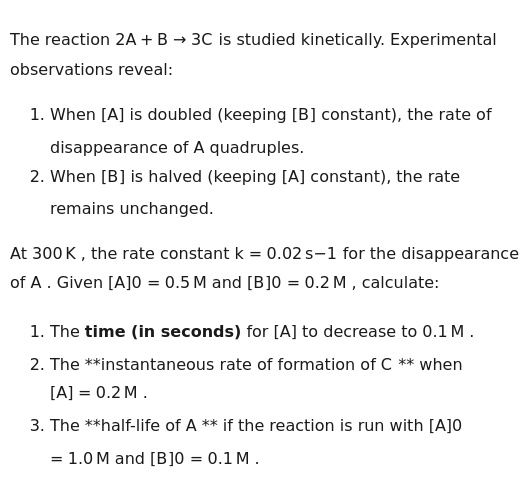Question
Question: The reaction \( 2A + B \rightarrow 3C \) is studied kinetically. Experimental observations reveal: ...
The reaction 2A+B→3C is studied kinetically. Experimental observations reveal:
- When [A] is doubled (keeping [B] constant), the rate of disappearance of A quadruples.
- When [B] is halved (keeping [A] constant), the rate remains unchanged.
At 300K, the rate constant k=0.02s−1 for the disappearance of A. Given [A]0=0.5M and [B]0=0.2M, calculate:
- The time (in seconds) for [A] to decrease to 0.1M.
- The instantaneous rate of formation of C when [A]=0.2M.
- The half-life of A if the reaction is run with [A]0=1.0M and [B]0=0.1M.

- 400 s, 2. 0.0012 M s^{-1}, 3. Not achievable
Solution
The problem involves determining the rate law from experimental data, handling inconsistencies in the given information, and then applying the derived rate law to calculate specific kinetic parameters.
1. Determine the Rate Law: The general rate law for the disappearance of A can be expressed as: −dtd[A]=k[A]x[B]y
- Observation 1: When [A] is doubled (keeping [B] constant), the rate of disappearance of A quadruples. This implies (2)x=4, so x=2. (The reaction is second order with respect to A).
- Observation 2: When [B] is halved (keeping [A] constant), the rate remains unchanged. This implies (0.5)y=1, so y=0. (The reaction is zero order with respect to B).
Thus, the rate law is: −dtd[A]=k[A]2 The overall order of the reaction is 2+0=2.
2. Address Inconsistency in Rate Constant Unit: For a second-order reaction, the units of the rate constant k should be (concentration)1−n(time)−1=M1−2s−1=M−1s−1. The problem states k=0.02s−1. This unit (s−1) is characteristic of a first-order reaction. Given the clear experimental data that unequivocally determines the order with respect to A as 2, we assume that the numerical value of k is correct, but its unit is misstated. Therefore, we will use k=0.02M−1s−1.
3. Calculate the time (in seconds) for [A] to decrease to 0.1M. Since the reaction is second order with respect to A (and zero order with respect to B, meaning [B] does not affect the rate), the integrated rate law for the disappearance of A is: [A]t1−[A]01=kt Given: [A]0=0.5M, [A]t=0.1M, k=0.02M−1s−1. 0.11−0.51=(0.02M−1s−1)t 10M−1−2M−1=0.02M−1s−1×t 8M−1=0.02M−1s−1×t t=0.028s=2800s=400s
4. Calculate the instantaneous rate of formation of C when [A]=0.2M. First, calculate the instantaneous rate of disappearance of A when [A]=0.2M: −dtd[A]=k[A]2 −dtd[A]=(0.02M−1s−1)(0.2M)2 −dtd[A]=(0.02)(0.04)Ms−1 −dtd[A]=0.0008Ms−1
Now, relate this rate to the rate of formation of C using the stoichiometry of the reaction 2A+B→3C. The general rate expression based on stoichiometry is: Rate=−21dtd[A]=−dtd[B]=+31dtd[C] We need the instantaneous rate of formation of C, +dtd[C]. From the stoichiometric relationship: −21dtd[A]=+31dtd[C] dtd[C]=−23dtd[A] Substitute the calculated rate of disappearance of A (which is a positive value): dtd[C]=23×(0.0008Ms−1) dtd[C]=3×0.0004Ms−1 dtd[C]=0.0012Ms−1
5. Calculate the half-life of A if the reaction is run with [A]0=1.0M and [B]0=0.1M. The half-life of A (t1/2) is the time required for [A] to decrease to half its initial concentration, i.e., [A]0/2=1.0M/2=0.5M. Let's check if A can reach this concentration given the initial amounts of reactants. Initial concentrations: [A]0=1.0M, [B]0=0.1M. The stoichiometry of the reaction is 2A+B→3C. This means 2 moles of A react with 1 mole of B. To decrease [A] from 1.0M to 0.5M, the amount of A consumed is Δ[A]=1.0−0.5=0.5M. Based on stoichiometry, the amount of B required to consume 0.5M of A would be: Δ[B]=21×Δ[A]=21×0.5M=0.25M. However, the initial concentration of B available is only [B]0=0.1M. Since the required amount of B (0.25 M) is greater than the available amount of B (0.1 M), B is the limiting reactant and will be completely consumed before A can reach its half-life concentration. When B is completely consumed (Δ[B]=0.1M), the amount of A consumed will be: Δ[A]=2×Δ[B]=2×0.1M=0.2M. The concentration of A remaining at this point will be: [A]=[A]0−Δ[A]=1.0M−0.2M=0.8M. Since A only decreases to 0.8M (and not 0.5M) before the reaction stops due to the exhaustion of B, the half-life of A is not achievable under these conditions.
